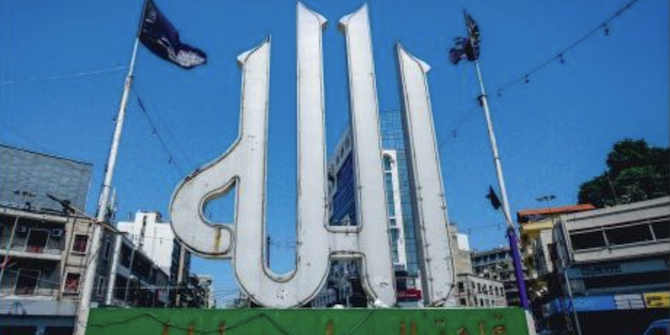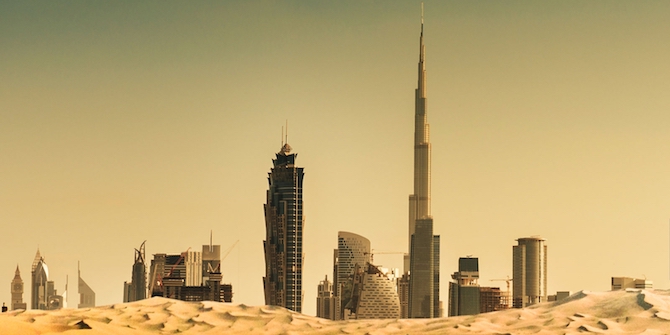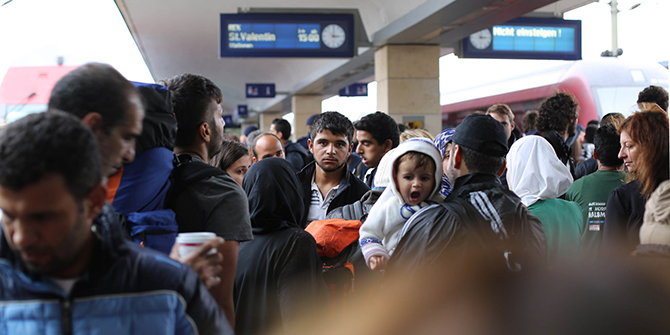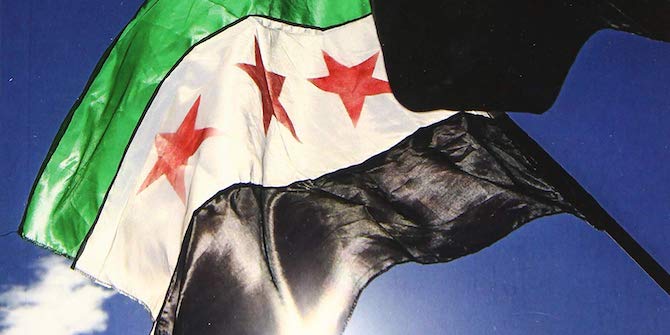 Drawing on years of research and access to unique sources, journalist David Patrikarakos’ new book, Nuclear Iran: The Birth of An Atomic State, just shortlisted for a International Affairs Book of the Year award, tells the history of Iran’s nuclear programme from its beginning under the Shah until the present day. Patrikarakos spoke about his book at LSE this week and a podcast of his talk should be available soon. Eskandar Sadeghi-Boroujerdi offers his review of the book.
Drawing on years of research and access to unique sources, journalist David Patrikarakos’ new book, Nuclear Iran: The Birth of An Atomic State, just shortlisted for a International Affairs Book of the Year award, tells the history of Iran’s nuclear programme from its beginning under the Shah until the present day. Patrikarakos spoke about his book at LSE this week and a podcast of his talk should be available soon. Eskandar Sadeghi-Boroujerdi offers his review of the book.
By Eskandar Sadeghi-Boroujerdi
A day doesn’t seem to go by when Iran is not in the headlines or the op-ed pages aren’t flooded with impassioned declamations of how to tackle the ‘Iranian threat’ and the ‘apocalyptic mullahs’, or conversely, that the deadlock over Iran’s nuclear programme is ‘manufactured’, ‘overblown’, or ‘the Iraq war redux’. Between these two extremes is the less frequented middle ground, which contends that some of Iran’s past research and activities are highly suspect and vigilance is a must, but also that a nuclear armed Iran is far from a foregone conclusion.
It is in the context of this heated, if somewhat over-saturated debate that writer and journalist David Patrikarakos has published, Nuclear Iran: The Birth of an Atomic State. The book proceeds chronologically, charting the Iranian nuclear programme’s inception under the monarchical imprimatur of Shah Mohammad Reza Pahlavi through to the present and its resumption after the Iranian revolution of 1978-9 under Ayatollah Ruhollah Khomeini’s Islamist theocracy. Nuclear Iran, unlike many other writings on the nuclear programme, starts from the very beginning and thereby offers some much needed historical perspective.
On the 8 December 1953, US President Dwight D. Eisenhower delivered his seminal ‘Atoms for Peace’ speech at the UN General Assembly and inaugurated the global non-proliferation regime In 1957, four years after Eisenhower’s speech, but also a CIA / MI6 orchestrated coup d’état which overthrew Iran’s nationalist Prime Minister, Mohammad Mosaddegh, the US and Iran signed a bilateral agreement for cooperation on the peaceful uses of nuclear technology. Or as Patrikarakos succinctly puts it, “Nuclear power was born in Iran; the USA was its midwife” (p16).
Iran’s nuclear programme did not, however, begin to make serious headway until the arrival on the scene of a young nuclear scientist by the name of Akbar Etemaad, the first head of the Atomic Energy Organization of Iran (AEOI). It is Etemaad who takes centre stage in Patrikarakos’s first 100 pages which deals with the nuclear programme during the Pahlavi era. This part of the book is largely based on interviews and various other exchanges with Etemaad, who currently resides in France and continues to be a vociferous defender of Iran’s civilian nuclear programme.
Etemaad’s perspective is a vital one and Patrikarakos is perhaps the first in English to comprehensively elaborate the views of the ‘father of Iran’s nuclear programme’ and its place in the Shah’s strategic vision for the country. This part of the book will be of great interest to those after some historical perspective on the programme, and it often reads as it is was Etemaad’s personal memoir. Patrikarakos does not engage Etemaad’s account critically in the course of the book, nor seek out much by way of sources which either corroborate or contradict the latter’s narrative. Nor does Patrikarakos even reference an extensive oral history conducted by Gholamhossein Afkhami and Farrokh Ghaffari of the Foundation for Iranian Studies in 1982, and which has since been published in book form as The Memoir of Akbar Etemaad: Iran’s Nuclear Energy Programme 1965-1978. Given that the interview given by Etemaad to the Foundation for Iranian Studies was considerably closer to the events under discussion, it is surprising that Patrikarakos has not checked it to see if the accounts differ in any respect, or whether there is additional information which he might have missed in the course of his own conversations with Etemaad.
A related concern is that one is hard pressed to find reference to any contemporary Iranian press reports from the time and therefore there is no clear picture of how the programme was represented to the Iranian public at the time. Because of its almost memoir format, the programme and thoughts about it remain restricted to the dyad of the Shah and Etemaad, and even here much of the account of what the Shah thought regarding the programme has been relayed by Etemaad to Patrikarakos. Asadollah Alam, the Minister of the Royal Court, and his extensive six volume diary which offers the most extensive account of the Shah’s daily and political life also quite incredibly does not feature anywhere in the book or the bibliography. And even though Patrikarakos has chosen a constructivist approach to frame his narrative, he relies exclusively on the English translation of Mohammad Reza Pahlavi’s Mission for My Country to make his point.
In any case, there is little doubt that Etemaad was integral to the professionalization of Iran’s nuclear programme, which had previously been headed by bureaucrats with only a superficial grasp of the technical details. Moreover, Nuclear Iran makes clear what many had previously thought. In short, – that the nuclear programme was the Shah’s pet project and in many ways indispensable to his modernizing drive for Iran. “He alone,” writes Patrikarakos, “had made the decision to launch a nuclear programme with almost no government consultation” (p18). The High Council of Atomic Energy Policy and the Committee of Nuclear Energy, which were in theory responsible for the AEOI, met no more than a couple of times and “the government just didn’t interfere” (p23).
While Etemaad would hold regular tutorials with the Shah and instruct him on the ins and outs of nuclear power, he soon came to realise that “he was desperate…for the idea of nuclear energy; at times it seemed that it was not even nuclear energy in itself, just anything…that would modernize Iran as quickly as possible” (p20). As a result of the pride of place assigned by the Shah, the programme had a virtually limitless budget; a budget which became the envy of many Cabinet Ministers. For the most part, this was encouraged by Western powers, with the French Foreign Ministry even creating a Nuclear Attaché for their embassy in Tehran (p36). It was not until 1975, however, that Iran signed a contract with the West German firm, Kraftwerk Union AG to build Iran’s first power plant along the Persian Gulf near the coastal city of Bushehr. It was scheduled to be finished by 1980 and after some discussion it was determined that it would be a ‘turnkey’ project whereby Kraftwerk would simply hand over the reactor once the power plant was completed (p38). Other Western states such as France and Belgium were also eager to cash in on the lucrative business of helping the Shah realise his ambitious plans for Iran’s nuclear industry.
Nuclear Iran is perhaps must helpful when addressing the US’s proliferation fears vis-à-vis the Pahlavi era nuclear programme where “Commercial imperatives were repeatedly subordinated to non-proliferation goals” (p71). Despite bilateral agreements between the two countries such as the June 1974 provisional agreement to supply Iran with two nuclear power reactors and enriched uranium fuel, Washington was keen to convey its opposition to Iran obtaining the full nuclear fuel cycle, even though, in contrast to other developing nations such as India or Pakistan, it had signed the Non-Proliferation Treaty (NPT) in February 1970. Iran’s signing up to the NPT had been done essentially “to keep Washington happy” (p56). As Patrikarakos also makes clear, the US under Nixon, Ford and Carter, was also adamantly opposed to Iran undertaking uranium reprocessing, which has the potential to yield a plutonium route to the atomic bomb. But again the Shah relented under American pressure, and made it clear that Iran would not pursue the reprocessing of its spent uranium fuel. The US even demanded a ‘right of prior consent’ clause, which would compel the AEOI to run all nuclear activities past Washington, but also obtain US approval on what Iran could do with the spent fuel of any reactor Iran purchased from Washington (p76-77).
The historical perspective deftly provided by Patrikarakos makes an important contribution to the public debate over Iran’s nuclear programme when so when many seem to belabour under the misconception that the US simply gave the Shah’s nuclear ambitions blanket support without qualification. In fact, as Patrikarakos makes clear, the relationship between the two allies was at times strained as a result of US non-proliferation policy. Carter’s Non-Proliferation Act of 1978 and the categorical refusal of Dixie Lee Ray, head of the U.S. Atomic Energy Commission, categorical to accept Iran’s right to the fuel cycle (p79), are two of several examples.
Regarding the Shah and nuclear weapons, Patrikarakos, based on his correspondences with Etemaad, shows that the Shah had entertained the possibility of pursuing weaponization, if other regional states decided upon such a path. This was all the more critical after India’s 1974 nuclear test. However, in reality no concrete steps were taken to weaponize Iran’s nuclear programme (p69) and if the decision were ever to be made it was at least a decade away from a bomb. The Shah instead chose to focus on conventional weaponry, and bought up state of the art armaments like no other autocrat of the developing world in the 1970s. However, given the Shah’s grandiose vision for Iran, the thought of “20 or 30 ridiculous little countries” developing nuclear weapons was more than the Shah could bear. If it ever occurred, he candidly told The New York Times in September 1975, a serious rethinking would be in order (p62, 68). Unlike the Islamic Republic today, the Pahlavi era nuclear programme never developed installations for uranium enrichment, and was focused on building power plants in order to reduce domestic oil consumption, in order to bolster the country’s foreign currency reserves. The Shah’s programme thus never developed a uranium path to a nuclear weapon (p72). In contrast, western, but also regional fears today revolve around the fact that the Islamic Republic has indeed mastered the nuclear fuel cycle, and while Iran is not enriching uranium beyond 19.75%, which technically speaking is Low Enriched Uranium (LEU), a political decision could change all that, in a short space of time. In short, the Islamic Republic’s ability to produce weapons grade uranium is today effectively a political decision, and not a matter of technical know-how, though to do so, would obviously violate its treaty obligations under the NPT.
I have focused more on the part of the book which deals with the Pahlavi era because it is the better researched part of the book, and largely informed by an individual, namely Akbar Etemaad, who knew pretty much everything there was to know about the nuclear programme. This is particularly so as it appears that the programme at the time was under the charge of essentially two people, Etemaad and his boss, the Shah. I also take this part of the book to be Patrikarakos’s most important contribution to the ongoing public debate vis-à-vis the Iranian nuclear programme. By placing it in its necessary historical context, we are able to see that the Islamic Republic is not an anomaly in its almost obsessive clinging to what it claims as its ‘inviolable right to peaceful nuclear energy’, but is in an important respect trying to build on the technological advances and progress made by the technocrats of the Pahlavi era, and claim Iran’s ‘rightful’ place in the regional order.
By chapter six, Nuclear Iran starts to address the Iranian Revolution of 1978-79 and the emergence of the hierocratic, Islamist state led by Ayatollah Ruhollah Khomeini, and it is here that things get more nebulous and difficult to reconstruct. The Iranian officials interviewed are sparse e.g. Ali Asghar Soltanieh, and / or still beholden to the official line we hear every day in the Western press, or arguably of little relevance e.g. Mohsen Sazegara, a low ranking official in the early eighties, a self-styled founder (amongst others) of the Revolutionary Guards, turned Reformist and exiled activist. Patrikarakos’ use of interviews with Western officials is far more illuminating. For example, his extensive reliance on interviews with Ambassador Peter Jenkins, the UK’s ambassador to the IAEA during the Islamic Republic’s negotiations with the EU3, but also other figures such as Ambassador John Bolton, the US ambassador to the UN under the Bush administration, offer a window into Western policymakers’ thinking at the time, and their disparate attitudes and approaches to the Iranian nuclear quandary.
A key point on which Nuclear Iran leaves one dissatisfied is the ideational-constructivist or identity politics approach to understanding Iran’s nuclear programme in the context of both the Pahlavi monarchical regime and the Islamic Republic. The main issue is that in the absence of any real depth in terms of either sources or analysis with respect to the ideational constructs of Pahlavi Iran and the Islamic Republic, it can only leave the intellectual historian bemused, while the often sketchy approach to the two distinct regimes’ actual process of political decision making and policy formation, will leave the political historian demanding greater detail on the thinking of the Iranian elite, beyond rehashed statements at the UN or IAEA denouncing the ‘injustice’ of the international order and ‘American hegemony’. This is especially the case regarding the post-revolutionary regime of the Islamic Republic.
At root, the issue is that while Patrikarakos ably weaves an assortment of official statements into a coherent narrative, they ultimately do not offer much insight into what was actually happening behind the scenes and the discussions which were unfolding at the time within the Iranian elite. For instance, he misses many important details such as the fact that Sadeq Tabatabai, a Deputy Prime Minister and relative of Khomeini, had approached the German Chancellor about restarting work at Bushehr as early as October 1979. Snippets and hints which occasionally featured in the contemporary Iranian press remain underutilized if utilized at all. For instance, none of former President Ali-Akbar Hashemi-Rafsanjani’s several volumes of memoirs for the 1980s are used, nor are any of his interview collections drawn upon. This is especially curious since by all accounts the role of Rafsanjani, the self-styled ‘Commander of the Reconstruction’, was of great importance to the nuclear programme’s development in the late eighties and early nineties.
Instead Patrikarakos for the most part relies on secondary literature and / or more recent interviews he has conducted with Western officials, many of whom remain anonymous. A good example is when Patrikarakos attributes a quote to the current Supreme Leader Ali Khamenei dating back to 1984, when the latter was President, then a far weaker institution than it is today, stating that “a nuclear arsenal would serve Iran as a ‘deterrent in the hands of God’s soldiers’” (p121). For such a sensitive admission, one would expect a primary source of some description or at the very least the original source as cited in another work. Instead we find a contentious 2012 report published by the Institute for Science and International Security, which while providing some useful analysis of the technical dimensions of Iran’s nuclear programme, is far from conversant in the history of the Islamic Republic. David Albright’s book Peddling Peril: How the Secret Nuclear Trade Arms America’s Enemies, who also happens to be the head of ISIS is then cited immediately after to attribute another quote to Khamenei, the original source for which we are left in the dark.
As many others have argued previously, the Shah saw himself as a benevolent leader and moderniser who sought to ‘restore’ Iran to the glory of its ancient past, while endeavouring to modernize his country along Western lines, as his father had done before him. The Islamic Republic, by contrast was born of a third wordlist, revolutionary Islamist creed, which advocated principles of self-determination and independence against foreign subjugation. Setting out these narratives certainly proves useful for context and Patrikarikos was right to present them, but such an approach becomes problematic when most if not all state and policy elite behaviour is depicted as a function of these overarching narratives. Moreover, while reading Nuclear Iran, one often finds these narratives being used to excuse lack of detail a propos institutional dynamics and political jockeying constitutive of the decision-making process and instead paint broad strokes and more general policy guidelines, which have been recounted countless times in the existing literature.
This is particularly the case in his overview of the nuclear diplomacy of the Islamic Republic, where the overwhelming majority of the theocratic state’s motivations are attributed to the Iranian intellectual, who was not in any straightforward sense a “secular Marxist” (p93) as Patrikarakos states, Jalal Al-e Ahmad. The latter’s conceptualization of ‘Gharbzadegi’ or Westoxification and even the Shi’i juridical and mystical theory of velayat-e faqih or the Guardianship of the Jurisconsult, the governing principal of the Islamic Republic of Iran which underwrites clerical rule, are repeatedly invoked to explain Iranian nuclear policy.
While Westoxification, or the Islamic Republic’s anti-Western ideology is repeatedly mentioned, the former Supreme National Security Council Chief (SNSC), Hassan Rowhani’s 1000 page volume Amniyat-e melli va diplomasi-ye hasteh’i, it is hardly used. There is only a single reference in the entirety of the footnotes, when the source is our best primary account thus far by a senior Iranian official. Even Ambassador Hossein Mousavian’s book, The Iranian Nuclear Crisis: A Memoir, another account by an important former member of Iran’s nuclear negotiating team and foreign policy establishment, hardly makes an appearance.
In fact, the Rowhani and Mousavian memoirs, two key players on the Iranian side, feature together in a single footnote (though Mousavian is mentioned once more in the footnotes), which verifies that in the course of the negotiations which led to Iran’s temporary suspension of uranium enrichment in October 2004, Rowhani, phoned both the Supreme Leader’s office and President Mohammad Khatami (p313), both of whom approved his making every effort to ensure the talks did not break down. Unfortunately, Patrikarakos barely scratches the surface of these sources, above all the Rowhani which is a veritable treasure trove as regards his tenure as head of the SNSC, and really should have made a great deal more use of it. Finally, the absence of a readily available work, former IAEA chief, Mohamed ElBaradei’s The Age of Deception: Nuclear Diplomacy in Treacherous Times, is surprising to say the least, especially since ElBaradei’s book has more chapters dedicated to Iran and his negotiations and discussions with Iranian officials, than any other country.
Patrikarakos is very good at explaining the basics of Iran’s nuclear programme in a way that is accessible to the uninitiated reader,. His presentation of some of the technical questions surrounding the Islamic Republic’s nuclear programme provide ample clarification. He outlines much of the alleged evidence which forms the basis of Western allegations that Iran had in the past engaged in research and experiments indicative of potential efforts to weaponize the nuclear programme e.g. the experiments with Polonium-210 (p203), the contentious laptop putatively handed over to the US by a ‘walk in’ which allegedly contained evidence that Iran had partaken in a number of research efforts aimed at weaponizing the programme. There is surprisingly no mention of Mohsen Fakhrizadeh in the book, the scientist affiliated to the Revolutionary Guards who allegedly headed the Iranian weapons programme at the Physics Research Center in Lavizan and now heads the Organization of Defensive Innovation and Research . The weapons programme currently lays dormant and has done so since approximately 2003. More research on this issue will probably elude us for many years to come, exactly because of its highly sensitive nature, but it should have at least been mentioned and perhaps probed further.
The remainder of the book competently traverses the various diplomatic near misses and lost opportunities such as the Vienna proposal of October 2009 and May 2010 Tehran Declaration concluded by Iran, Brazil and Turkey. But to be honest, Trita Parsi’s A Single Roll of the Dice: Obama’s Diplomacy with Iran which is the best and most comprehensive book thus far on Obama’s Iran policy is superior on this score, but also left unreferenced and interviews many more of the personalities who were central to the various diplomatic wranglings in question.
At the end of the book, Patrikarakos tells readers that ultimately Iran is in pursuit of a nuclear capability, which essentially amounts to the ability to build a nuclear weapon in a short space of time if the political leadership deems it necessary. This same conclusion was drawn by most level-headed analysts some years ago. But he also frames the programme well in terms of the Iranian elite’s recurring idea of their country’s ‘rightful place’ in the region and broader world. He successfully illustrates how much of Iran’s so-called “nuclear nationalism” stems less from a drive to overthrow the international order and more from a desire to have Iran’s value as a regional player incorporated into the security architecture of the region, and thereby recognised by the Western powers.
Nuclear Iran is certainly a welcome contribution which should be read by all those interested in one of the most important international deadlocks of the 21st century, but the subject matter, particularly its contemporary nature, militates against the prospect of a fully-fledged history and academic treatment of the subject. Errors in transliteration, media cliches such as regular references to ‘mullahs’ as a shorthand for the IRI establishment, and the regular regurgitation of tropes such as that of ‘hardliners vs. reformers’ give Nuclear Iran the air of being a serious piece of journalism, which is to be superseded in the years to come, rather than an enduring historical tome. It is however a very readable work on perhaps the burning foreign policy issue of the day. Despite the overwhelming amount of sensationalist drivel written on the subject, Patrikarakos has managed to write a largely balanced and fair account of the programme to date. It’s unlikely that we will see a proper history of the programme, particularly under the Islamic Republic, until some years after this impasse has finally been resolved and relegated to the historical archive.
 Eskandar Sadeghi-Boroujerdi is the editor of Iran Pulse at the New York-based website, Al Monitor. He was formerly an Iran Researcher at Oxford Research Group and is currently a doctoral researcher of Modern Middle Eastern Studies with a focus on post-revolutionary Iran at Queen’s College, University of Oxford. He has published on Iranian political affairs in numerous venues, including Foreign Policy, Al-Jazeera English, The Guardian, Al-Monitor, British Journal of Middle Eastern Studies, Lobe Log, e-International Relations, PBS Frontline: Tehran Bureau, amongst others.
Eskandar Sadeghi-Boroujerdi is the editor of Iran Pulse at the New York-based website, Al Monitor. He was formerly an Iran Researcher at Oxford Research Group and is currently a doctoral researcher of Modern Middle Eastern Studies with a focus on post-revolutionary Iran at Queen’s College, University of Oxford. He has published on Iranian political affairs in numerous venues, including Foreign Policy, Al-Jazeera English, The Guardian, Al-Monitor, British Journal of Middle Eastern Studies, Lobe Log, e-International Relations, PBS Frontline: Tehran Bureau, amongst others.
The MEC Blog offers opinion pieces from time to time. MEC does not endorse the content of pieces, nor do they reflect any corporate view of the MEC.







‘Unlike the Islamic Republic today, the Pahlavi era nuclear programme never developed installations for uranium enrichment’
Well, the Esfehan Nuclear Technology Center was specifically set-up in 1974 with the French to provide Iran with the entire nuclear fuel cycle . The Shah was adamant about enrichment though he relented on reprocessing (of US-origin nuclear material.) Iran may not have actually produced the centrifuges etc but there’s no question that even then, Iran was intent on acquiring enrichment capability.